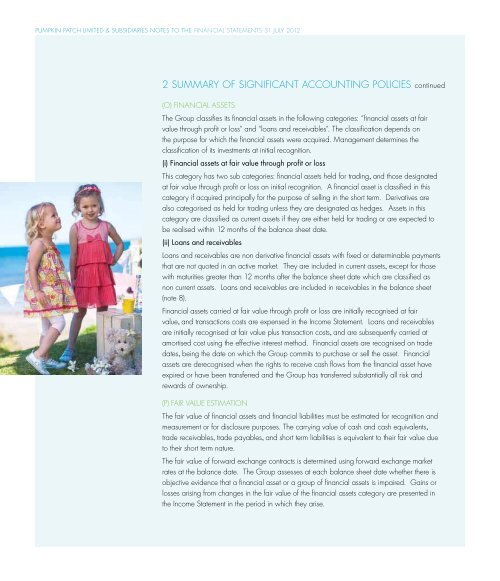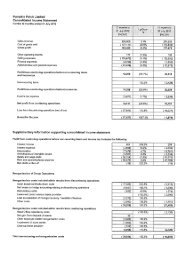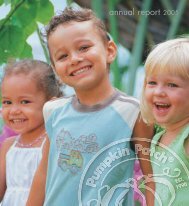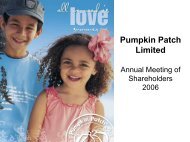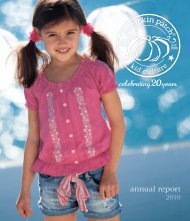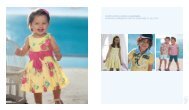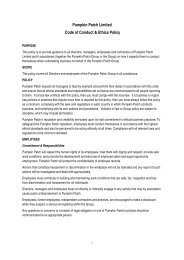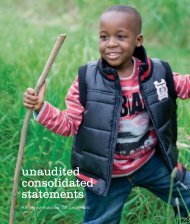annual report 2012 - Pumpkin Patch investor relations
annual report 2012 - Pumpkin Patch investor relations
annual report 2012 - Pumpkin Patch investor relations
- No tags were found...
Create successful ePaper yourself
Turn your PDF publications into a flip-book with our unique Google optimized e-Paper software.
pumpkin patch limited & subsidiaries NOTES TO THE financial statements 31 july <strong>2012</strong>pumpkin patch limited & subsidiaries NOTES TO THE financial statements 31 july <strong>2012</strong>2 summary of significant accounting policies continued(o) Financial assetsThe Group classifies its financial assets in the following categories: “financial assets at fairvalue through profit or loss” and “loans and receivables”. The classification depends onthe purpose for which the financial assets were acquired. Management determines theclassification of its investments at initial recognition.(i) Financial assets at fair value through profit or lossThis category has two sub categories: financial assets held for trading, and those designatedat fair value through profit or loss on initial recognition. A financial asset is classified in thiscategory if acquired principally for the purpose of selling in the short term. Derivatives arealso categorised as held for trading unless they are designated as hedges. Assets in thiscategory are classified as current assets if they are either held for trading or are expected tobe realised within 12 months of the balance sheet date.(ii) Loans and receivablesLoans and receivables are non derivative financial assets with fixed or determinable paymentsthat are not quoted in an active market. They are included in current assets, except for thosewith maturities greater than 12 months after the balance sheet date which are classified asnon current assets. Loans and receivables are included in receivables in the balance sheet(note 8).Financial assets carried at fair value through profit or loss are initially recognised at fairvalue, and transactions costs are expensed in the Income Statement. Loans and receivablesare initially recognised at fair value plus transaction costs, and are subsequently carried atamortised cost using the effective interest method. Financial assets are recognised on tradedates, being the date on which the Group commits to purchase or sell the asset. Financialassets are derecognised when the rights to receive cash flows from the financial asset haveexpired or have been transferred and the Group has transferred substantially all risk andrewards of ownership.(p) Fair value estimationThe fair value of financial assets and financial liabilities must be estimated for recognition andmeasurement or for disclosure purposes. The carrying value of cash and cash equivalents,trade receivables, trade payables, and short term liabilities is equivalent to their fair value dueto their short term nature.The fair value of forward exchange contracts is determined using forward exchange marketrates at the balance date. The Group assesses at each balance sheet date whether there isobjective evidence that a financial asset or a group of financial assets is impaired. Gains orlosses arising from changes in the fair value of the financial assets category are presented inthe Income Statement in the period in which they arise.(q) Property, plant and equipmentAll property, plant and equipment is stated at historical cost less depreciation and impairment.Historical cost includes expenditure that is directly attributable to the acquisition of the items.Subsequent costs are included in the asset’s carrying amount or recognised as a separateasset, as appropriate, only when it is probable that future economic benefits associated withthe item will flow to the Group and the cost of the item can be measured reliably. All repairsand maintenance are charged to the Income Statement during the financial period in whichthey are incurred.Land is not depreciated. Depreciation on other assets is calculated using the straight linemethod to allocate their costs, net of their residual values, over their estimated useful lives,as follows:‐ Shop fit out.........................................................................................5‐10 years‐ Office equipment (including furniture and fittings (F&F)).................................5‐10 years‐ Computer equipment (including point of sale equipment (POS))......................3‐5 years‐ Plant and machinery.............................................................................3‐7 years‐ Vehicles.............................................................................................4‐5 years‐ Leasehold improvements........................................................................6‐7 yearsThe assets’ residual values and useful lives are reviewed, and adjusted if appropriate, at eachbalance sheet date.An asset’s carrying amount is written down immediately to its recoverable amount if the asset’scarrying amount is greater than its estimated recoverable amount.Gains and losses on disposals are determined by comparing proceeds with carrying amount.These are included in the Income Statement.(r) Intangible assets(i) TrademarksTrademarks have a finite useful life and are carried at cost less accumulated amortisation andimpairment losses. Amortisation is calculated using the straight line method to allocate thecost of trademarks and licences over their estimated useful lives (three to five years).(ii) Software costsAcquired computer software licences are capitalised on the basis of the costs incurred toacquire and bring to use the specific software. These costs are amortised over their estimateduseful lives (three to five years).Costs associated with developing or maintaining computer software programmes arerecognised as an expense as incurred. Costs that are directly associated with the productionof identifiable and unique software products controlled by the Group, and that will probably55


